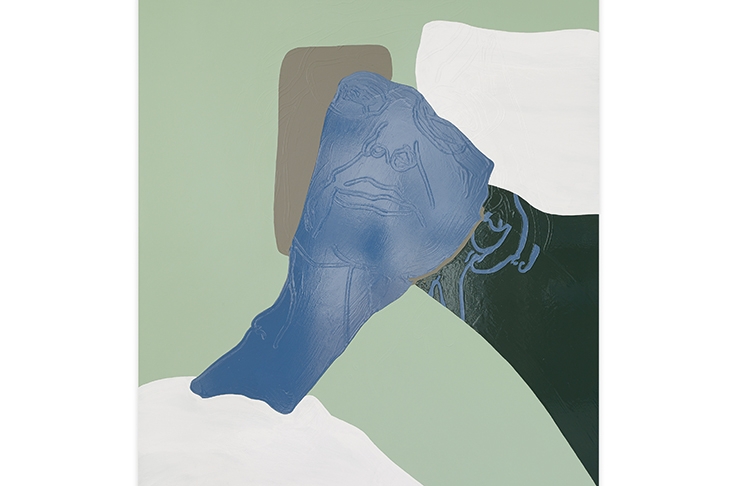Last year, Gary Hume made a painting of himself paddling. At a casual glance, or even a longer look, it might not appear to be what it is. What you see is a wrinkled, pinkish surface with a sort of dome of curving green and blueish shapes at the bottom. This, to Hume, is a sort of self-portrait as a child at the seaside. ‘I’m on the beach, I’ve got the ripples going around my ankles making little coloured shapes, and all the sand.’
Hume’s paintings are like that. They may look abstract, but it turns out that they are startlingly real. One from some years ago consists of six shiny black rectangles with yellow bars between them. In one way, it’s a recycling of one of the best known of all abstract paintings, Malevich’s ‘Black Square’ of 1915; in another, it’s a startling piece of realism, exactly what a dark window looks like at night.
If you peer into Hume’s paintings, you can see your own reflection. That’s because his medium of choice is not oils or watercolour, but household gloss. Consequently, his paintings have the smooth, reflective quality of a well-painted door. And indeed, doors — the big swing-type ones through which you enter a hospital ward or operating theatre — were the subject of the first series of works with which Hume came to fame.
Again, these looked like arrangements of circles and oblongs (the windows and panels on the doors). At the same time, they were almost facsimiles of reality: door-shaped objects, painted in gloss you could buy at a hardware store.
Initially, Hume was associated with the Young British Artists of the 1990s such as Damien Hirst and Tracey Emin. With the softly beautiful quality of his work in mind, however, and the household gloss, you might say that he was as much DIY as YBA.
Twenty years have passed since the Sensation exhibition in which the YBAs came to artwork stardom. Hume is no longer thirtysomething, but a mature artist of 55. Four years ago he had a retrospective at Tate
Britain, shown in parallel with one by a wonderful painter of an earlier generation, Patrick Caulfield.
That pairing suggested a better way to think of Hume than as part of a loose grouping such as the YBAs: he is one of a quirky line of British painters who sit right on the borderline between abstract and figurative art (Howard Hodgkin was another). So Hume can be connected with a sort of tradition, but like all worthwhile artists brings something fresh. Frank Auerbach, a veteran observer of painting, mused recently that there is something new about space in Hume’s work (perhaps it’s because of that unreproducible mirror-smooth gloss).
When I ask Hume whether he feels he belongs to a tradition, the answer is revealing: ‘The only tradition that matters is of artists who, whatever their work looks like, are truthful. That’s one of those non-empirical judgments: you can’t be 100 per cent sure of it, but you just believe them to be truthful.’
Style has nothing to do with it. ‘It doesn’t make any difference what it looks like because every artist can only make what they make. That might seem entirely ridiculous. You’d think we should be able to do what we like. But it turns out we can only do what we can.’
So Hume’s recipe for being an artist involves probity. ‘Avoid an easy fix, something that is pleasing because everybody knows about it already, or which you don’t care about, but looks good. That all has to go in the bin.’
For Hume, a painting has to be a picture, by which he means ‘not an abstraction’. And a picture is ‘something to do with the world and not about art’. He quickly goes on to say that he loves abstract art; he just can’t make it himself. Recently, in fact, he tried. He made a series of very minimal paintings: ‘I was very excited and worked for a month making more of these things — just large stripes, really, thinking, “Oh God, these look really excellent!” After a month, they all went in the bin.’
Instead, he made a picture of a striped thing: a windbreak. ‘That you might have thought I could just paint, without looking at an actual windbreak, but it turned out I couldn’t at all,’ Hume remembers. ‘I ended up with a flag. So I had to do it again, go and buy a windbreak and copy it.’ And to him, a windbreak isn’t just a thing to stop the breeze, it’s roughly what a small cake dipped in tea was to Marcel Proust.
‘To me it is an incredibly happy object. It reminds me of great holidays, and also of the huge amount of care and tending by my mum. Of course, she put it up, doing every damn thing, in what was always a slightly chaotic atmosphere with everybody changing. All this is going on, with the windbreak making a sort of family home.’
Hume is currently going through an experience that happens to many people in their fifties and sixties: the final illness of a parent. ‘My mum’s got dementia,’ he explains, ‘and there’s been this slow goodbye. I’m trying to make these tender paintings in what is really quite an untender situation. Maybe death is tender, I don’t know. It doesn’t feel like that. But that’s how I’m trying to be, watching her death.’
‘How do I do a painting of my mum and somehow have the elusive quality of her now? So much now is our memories of her, rather than her actually being here.’ So his new pictures are of fragments of the past recalled and of somebody now slipping away. Hume famously said of himself: ‘All you get of me is the surface.’ But the more you look, the more depths you find.






Comments